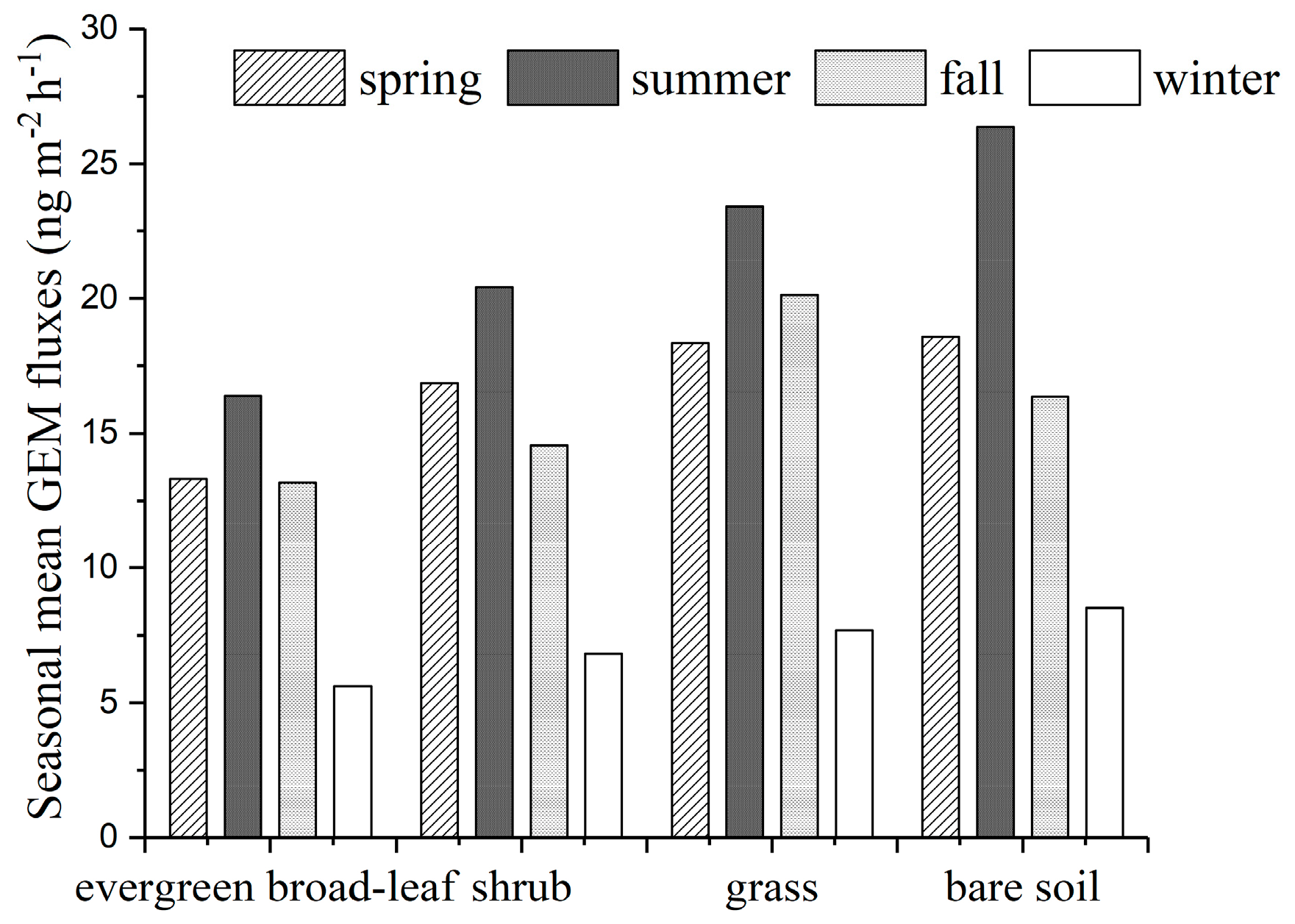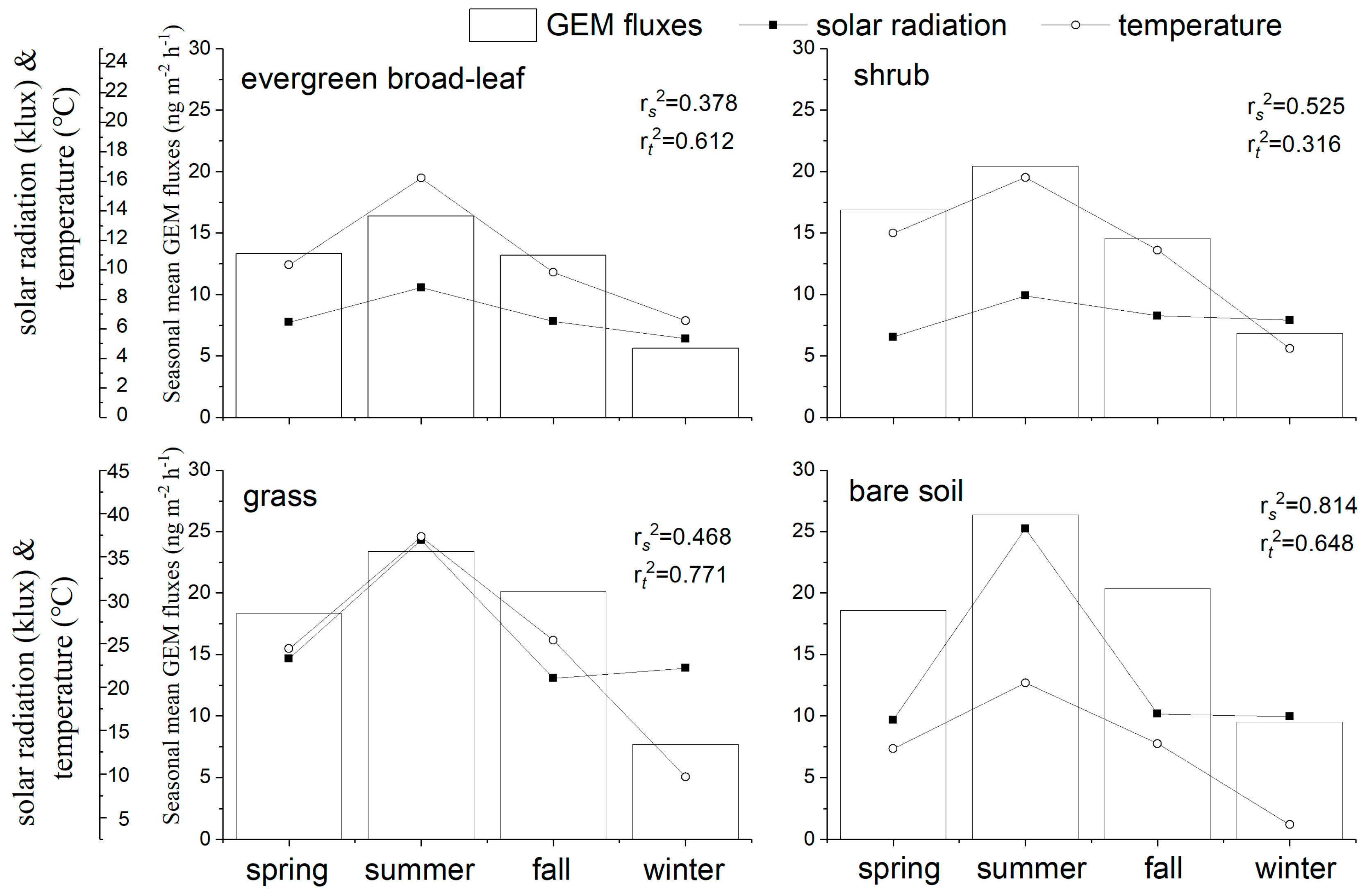A Two-Year Study on Mercury Fluxes from the Soil under Different Vegetation Cover in a Subtropical Region, South China
Abstract
:1. Introduction
2. Materials and Methods
2.1. Site Description
2.2. Measurement of GEM Fluxes
2.3. Measurement of the Blank
2.4. Measurement of Atmospheric Parameters
2.5. Statistical Analysis
3. Results and Discussion
3.1. Seasonal Dynamics of GEM Fluxes at the Soil–Air Interface under Different Vegetation Cover Types
3.2. Effect of Temperature and Solar Radiation on the GEM Flux under Different Vegetation Cover Types
3.3. Diurnal Variation Characteristics of GEM Flux under Different Vegetation Cover Types
4. Conclusions
Supplementary Materials
Acknowledgments
Author Contributions
Conflicts of Interest
References
- Mergler, D.; Anderson, H.A.; Chan, L.H.M.; Mahaffey, K.R.; Murray, M.; Sakamoto, M.; Stern, A.H. Methylmercury exposure and health effects in humans—A worldwide concern. Ambio 2007, 36, 3–11. [Google Scholar] [CrossRef]
- Eckley, C.S.; Blanchard, P.; Mclennan, D.; Mintz, R.; Sekela, M. Soil–Air mercury flux near a large industrial emission source before and after closure (Flin Flon, Manitoba, Canada). Environ. Sci. Technol. 2015, 49, 9750–9757. [Google Scholar] [CrossRef] [PubMed]
- Driscoll, C.T.; Mason, R.P.; Chan, H.M.; Jacob, D.J.; Pirrone, N. Mercury as a global pollutant: Sources, pathways, and effects. Environ. Sci. Technol. 2013, 47, 4967–4983. [Google Scholar] [CrossRef] [PubMed]
- Poissant, L.; Pilote, M.; Constant, P.; Zhang, H. A year of continuous measurements of three atmospheric mercury species (GEM, RGM and HGP) in southern Québec, Canada. Atmos. Environ. 2005, 39, 1275–1287. [Google Scholar] [CrossRef]
- Bergan, T.; Gallardo, L.; Rodhe, H. Mercury in the global troposphere: A three-dimensional model study. Atmos. Environ. 1999, 33, 1575–1585. [Google Scholar] [CrossRef]
- Schroeder, W.H.; Munthe, J. Atmospheric mercury an overview. Atmos. Environ. 1998, 32, 809–822. [Google Scholar] [CrossRef]
- Agnan, Y.; Le Dantec, T.; Moore, C.W.; Edwards, G.C.; Obrist, D. New constraints on terrestrial surface-atmosphere fluxes of gaseous elemental mercury using a global database. Environ. Sci. Technol. 2016, 50, 507–524. [Google Scholar] [CrossRef] [PubMed]
- Silva-Filho, E.V.; Machado, W.; Oliveira, R.R.; Sella, S.M.; Lacerda, L.D. Mercury deposition through litterfall in an Atlantic forest at Ilha Grande, southeast Brazil. Chemosphere 2006, 65, 2477–2484. [Google Scholar] [CrossRef] [PubMed]
- Blackwell, B.D.; Driscoll, C.T.; Maxwell, J.A.; Holsen, T.M. Changing climate alters inputs and pathways of mercury deposition to forested ecosystems. Biogeochemistry 2014, 119, 215–228. [Google Scholar] [CrossRef]
- Smith, W.H. Air pollution and forests: Interactions between air contaminants and forest ecosystems. For. Ecol. Manag. 1983, 9, 410–412. [Google Scholar]
- Jiskra, M.; Wiederhold, J.G.; Skyllberg, U.; Kronberg, R.M.; Hajdas, I.; Kretzschmar, R. Mercury deposition and re-emission pathways in boreal forest soils investigated with Hg isotope signatures. Environ. Sci. Technol. 2015, 49, 7188–7196. [Google Scholar] [CrossRef] [PubMed]
- Zhang, L.M.; Wright, L.P.; Blanchard, P. A review of current knowledge concerning dry deposition of atmospheric mercury. Atmos. Environ. 2009, 43, 5853–5864. [Google Scholar] [CrossRef]
- Zhang, L.; Blanchard, P.; Gay, D.A.; Prestbo, E.M.; Risch, M.R.; Johnson, D.; Narayan, J.; Zsolway, R.; Holsen, T.M.; Miller, E.K.; et al. Estimation of speciated and total mercury dry deposition at monitoring locations in eastern and central North America. Atmos. Chem. Phys. 2012, 12, 4327–4340. [Google Scholar] [CrossRef] [Green Version]
- Wan, Q.; Feng, X.; Zheng, W.; Lu, Y.J.; Han, S.; Xu, H. Seasonal variation of total gaseous mercury in changbai mountain area. Environ. Sci. 2008, 29, 296–299. (In Chinese) [Google Scholar]
- Demers, J.D.; Blum, J.D.; Zak, D.R. Mercury isotopes in a forested ecosystem: Implications for air-surface exchange dynamics and the global mercury cycle. Glob. Biogeochem. Cycles 2013, 27, 222–238. [Google Scholar] [CrossRef]
- Fu, X.W.; Feng, X.; Dong, Z.Q.; Yin, R.S.; Wang, J.X.; Yang, Z.R.; Zhang, H. Atmospheric gaseous elemental mercury (GEM) concentrations and mercury depositions at a high-altitude mountain peak in south China. Atmos. Chem. Phys. 2010, 10, 2425–2437. [Google Scholar] [CrossRef]
- Lu, Z.; Wang, X.; Zhang, Y.; Zhang, Y.J.; Luo, K.; Sha, L. High mercury accumulation in two subtropical evergreen forests in South China and potential determinants. J. Environ. Manag. 2016, 183, 488–496. [Google Scholar] [CrossRef] [PubMed]
- Eckley, C.S.; Tate, M.T.; Lin, C.J.; Gustin, M.; Dent, S.; Eagles-Smith, C.; Lutz, M.A.; Wickland, K.P.; Wang, B.; Gray, J.E.; et al. Surface-air mercury fluxes across western north America: A synthesis of spatial trends and controlling variables. Sci. Total Environ. 2016, 568, 651–665. [Google Scholar] [CrossRef] [PubMed]
- Lindberg, S.E.; Price, J.L. Airborne emissions of mercury from municipal landfill Operations: A short-term measurement study in Florida. J. Air Waste Manag. 1999, 49, 520–532. [Google Scholar] [CrossRef] [PubMed]
- Zhang, H.; Lindberg, S.E.; Marsik, F.J. Mercury air/surface exchange kinetics of background soils of the Tahquamenon river in the Michigan upper peninsula. Water Air Soil Pollut. 2001, 126, 151–169. [Google Scholar] [CrossRef]
- Carpi, A.; Lindberg, S.E. Application of a TeflonTM dynamic flux chamber for quantifying soil mercury flux: Tests and results over background soil. Atmos. Environ. 1998, 32, 873–882. [Google Scholar] [CrossRef]
- Gustin, M.S.; Biester, H.; Kim, C.S. Investigation of the light-enhanced emission of mercury from naturally enriched substrates. Atmos. Environ. 2002, 36, 3241–3254. [Google Scholar] [CrossRef]
- Zhang, L.; Wang, S.; Meng, Y.; Hao, J. Influence of mercury and chlorine content of coal on mercury emissions from coal-fired power plants in China. Environ. Sci. Technol. 2012, 46, 6385–6392. [Google Scholar] [CrossRef] [PubMed]
- Pacyna, E.G.; Pacyna, J.M.; Steenhuisen, F.; Wilson, S. Global anthropogenic mercury emission inventory for 2000. Atmos. Environ. 2006, 40, 4048–4063. [Google Scholar] [CrossRef]
- Almeida, M.D.; Marins, R.V.; Paraquetti, H.H.M.; Bastos, W.R.; Lacerda, L.D. Mercury degassing from forested and open field soils in Rondônia, Western Amazon, Brazil. Chemosphere 2009, 77, 60–66. [Google Scholar] [CrossRef] [PubMed]
- Choi, H.; Thomas, M.H. Gaseous mercury fluxes from the forest floor of the Adirondacks. Environ. Pollut. 2009, 157, 592–600. [Google Scholar] [CrossRef] [PubMed]
- Wang, D.; He, L.; Shi, X.; Wei, S.; Feng, X. Release flux of mercury from different environmental surfaces in Chongqing, China. Chemosphere 2006, 64, 1845–1854. [Google Scholar] [CrossRef] [PubMed]
- Wang, S.; Feng, X.; Qiu, G.; Shang, L.; Li, P.; Wei, Z. Mercury concentrations and air/soil fluxes in Wuchuan mercury mining district, Guizhou province, China. Atmos. Environ. 2007, 41, 5984–5993. [Google Scholar] [CrossRef]
- Fu, X.; Feng, X.; Wang, S.; Qiu, G.; Li, P. Mercury flux rate of two types of grasslands in Guiyang. Res. Environ. Sci. 2007, 20, 33–37. (In Chinese) [Google Scholar]
- Wang, Y.; Peng, Y.; Wang, D.; Zhang, C. Wet deposition fluxes of total mercury and methylmercury in core urban areas, Chongqing, China. Atmos. Environ. 2014, 92, 87–96. [Google Scholar] [CrossRef]
- Ma, M.; Wang, D.; Shen, Y.; Sun, R.; Huang, L. Mercury fluxes from conifer-broadleaf forested field in central subtropical forest zone. Environ. Sci. 2014, 35, 85–92. (In Chinese) [Google Scholar]
- Wang, S.; Feng, X.; Qiu, G.; Fu, X.; Wei, Z. Characteristics of mercury exchange flux between soil and air in the heavily air-polluted area, eastern Guizhou, China. Atmos. Environ. 2007, 41, 5584–5594. [Google Scholar] [CrossRef]
- Walters, N.E.; Glassford, S.M.; Heyst, B.J.V. Mercury flux from naturally enriched bare soils during simulated cold weather cycling. Atmos. Environ. 2016, 129, 134–141. [Google Scholar] [CrossRef]
- Artaxo, P.; de Campos, R.C.; Fernandes, E.T.; Martins, J.V.; Xiao, Z.F.; Lindqvist, O.; Fernandez-Jimenez, M.T. Large scale mercury and trace element measurements in the Amazon basin. Atmos. Environ. 2000, 34, 4085–4096. [Google Scholar] [CrossRef]
- Lindberg, S.E.; Stratton, W.J. Atmospheric mercury speciation: Concentrations and behavior of reactive gaseous mercury in ambient air. Environ. Sci. Technol. 1998, 32, 49–57. [Google Scholar] [CrossRef]
- Ferrara, R.; Maserti, B.E.; Andersson, M.; Edner, H.; Ragnarson, P.; Svanberg, S. Mercury degassing rate from mineralized areas in the Mediterranean Basin. Water Air Soil Pollut. 1997, 93, 59–66. [Google Scholar] [CrossRef]
- Rinklebe, J.; During, A.; Overesch, M.; Du, L.G.; Wennrich, R.; Stärk, H.J.; Mothes, S. Dynamics of mercury fluxes and their controlling factors in large Hg-polluted floodplain areas. Environ. Pollut. 2010, 158, 308–318. [Google Scholar] [CrossRef] [PubMed]
- Sizmur, T.; Mcarthur, G.; Risk, D.; Tordon, R.; O’Driscoll, N.J. Gaseous mercury flux from salt marshes is mediated by solar radiation and temperature. Atmos. Environ. 2017, 153, 117–125. [Google Scholar] [CrossRef]
- Ma, M.; Wang, D.; Sun, R.; Shen, Y.; Huang, L. Gaseous mercury emissions from subtropical forested and open field soils in a national nature reserve, southwest china. Atmos. Environ. 2013, 64, 116–123. [Google Scholar] [CrossRef]
- Fu, X.; Feng, X.; Zhu, W.; Rothenberg, S.; Yao, H.; Zhang, H. Elevated atmospheric deposition and dynamics of mercury in a remote upland forest of southwestern china. Environ. Pollut. 2010, 158, 2324–2333. [Google Scholar] [CrossRef] [PubMed]
- Wang, Z.; Zhang, X.; Xiao, J.; Ci, Z.; Yu, P. Mercury fluxes and pools in three subtropical forested catchments, southwest China. Environ. Pollut. 2009, 157, 801–808. [Google Scholar] [CrossRef] [PubMed]
- Howard, D.; Edwards, G.C. Mercury fluxes over an Australian alpine grassland and observation of nocturnal atmospheric mercury depletion events. Atmos. Chem. Phys. 2017, 1–24. [Google Scholar] [CrossRef]
- Niu, Z.; Zhang, X.; Wang, Z.; Ci, Z. Mercury in leaf litter in typical suburban and urban broadleaf forests in China. J. Environ. Sci. 2011, 23, 2042–2048. [Google Scholar] [CrossRef]
- Sheehan, K.D.; Feranadez, I.J.; Kahl, J.S.; Amirbahman, A. Litterfall mercury in two forested watersheds at Acadia National Park, Maine, USA. Water Air Soil Pollut. 2006, 170, 249–264. [Google Scholar] [CrossRef]



| Vegetation Covers | GEM Fluxes (ng·m−2·h−1) | |||||
|---|---|---|---|---|---|---|
| Mean | Median | Max | Min | SD | N | |
| Evergreen broad-leaf | 11.23 | 10.25 | 42.12 | −3.18 | 11.13 | 4048 |
| Shrub | 12.83 | 11.46 | 55.31 | −2.68 | 10.22 | 4022 |
| Grass | 14.73 | 18.20 | 82.01 | −4.02 | 18.84 | 4018 |
| Bare soil | 15.32 | 12.68 | 49.65 | −4.15 | 10.44 | 4057 |
| Location | Vegetation Covers | Hg Flux (ng m−3) | Literature |
|---|---|---|---|
| Global | natural emission | 0.7–1.1 | [34] |
| Sweden | forest field | −1.30–1.40 | [35] |
| Adirondacks, USA | temperate forest | −2.5–27.2 | [26] |
| Amazon Basin | primeval forest | 0.5–2 | [24] |
| Italy | forest field | −0.5–6 | [36] |
| Rondnia | forest field | 0.8 ± 0.2 | [25] |
| Elbe region | flood plain | 30.97 ± 30.77 | [37] |
| Wanshan China | mercury mine | 33–3638 | [28] |
| Guiyang China | glass land | (718 ± 1517)–(4115 ± 1512) | [29] |
| Changbai Mountain | temperate forest | 4.4 ± 28.74 | [27] |
| Mt. Simian | evergreen broad-leaf | 11.23 ±11.13 | this study |
| Mt. Simian | shrub | 12.83 ±10.22 | this study |
| Mt. Simian | grass | 14.73 ± 18.84 | this study |
| Mt. Simian | bare soil | 15.32 ± 10.44 | this study |
© 2018 by the authors. Licensee MDPI, Basel, Switzerland. This article is an open access article distributed under the terms and conditions of the Creative Commons Attribution (CC BY) license (http://creativecommons.org/licenses/by/4.0/).
Share and Cite
Ma, M.; Sun, T.; Du, H.; Wang, D. A Two-Year Study on Mercury Fluxes from the Soil under Different Vegetation Cover in a Subtropical Region, South China. Atmosphere 2018, 9, 30. https://doi.org/10.3390/atmos9010030
Ma M, Sun T, Du H, Wang D. A Two-Year Study on Mercury Fluxes from the Soil under Different Vegetation Cover in a Subtropical Region, South China. Atmosphere. 2018; 9(1):30. https://doi.org/10.3390/atmos9010030
Chicago/Turabian StyleMa, Ming, Tao Sun, Hongxia Du, and Dingyong Wang. 2018. "A Two-Year Study on Mercury Fluxes from the Soil under Different Vegetation Cover in a Subtropical Region, South China" Atmosphere 9, no. 1: 30. https://doi.org/10.3390/atmos9010030





